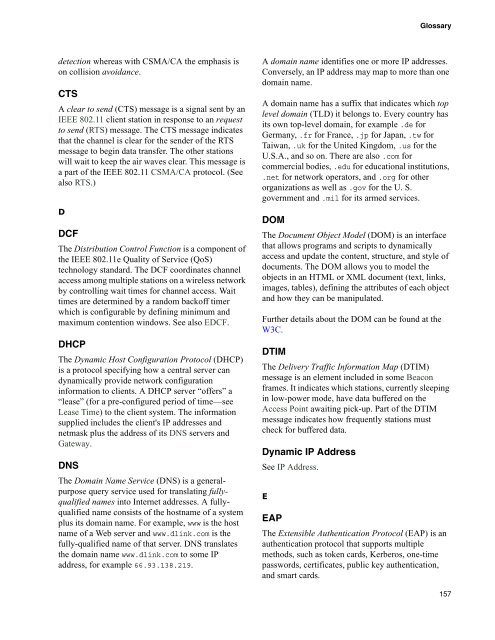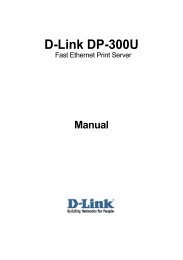Unified Access Point (AP) Administrator's Guide
Unified Access Point (AP) Administrator's Guide
Unified Access Point (AP) Administrator's Guide
Create successful ePaper yourself
Turn your PDF publications into a flip-book with our unique Google optimized e-Paper software.
detection whereas with CSMA/CA the emphasis is<br />
on collision avoidance.<br />
CTS<br />
A clear to send (CTS) message is a signal sent by an<br />
IEEE 802.11 client station in response to an request<br />
to send (RTS) message. The CTS message indicates<br />
that the channel is clear for the sender of the RTS<br />
message to begin data transfer. The other stations<br />
will wait to keep the air waves clear. This message is<br />
a part of the IEEE 802.11 CSMA/CA protocol. (See<br />
also RTS.)<br />
D<br />
DCF<br />
The Distribution Control Function is a component of<br />
the IEEE 802.11e Quality of Service (QoS)<br />
technology standard. The DCF coordinates channel<br />
access among multiple stations on a wireless network<br />
by controlling wait times for channel access. Wait<br />
times are determined by a random backoff timer<br />
which is configurable by defining minimum and<br />
maximum contention windows. See also EDCF.<br />
DHCP<br />
The Dynamic Host Configuration Protocol (DHCP)<br />
is a protocol specifying how a central server can<br />
dynamically provide network configuration<br />
information to clients. A DHCP server “offers” a<br />
“lease” (for a pre-configured period of time—see<br />
Lease Time) to the client system. The information<br />
supplied includes the client's IP addresses and<br />
netmask plus the address of its DNS servers and<br />
Gateway.<br />
DNS<br />
The Domain Name Service (DNS) is a generalpurpose<br />
query service used for translating fullyqualified<br />
names into Internet addresses. A fullyqualified<br />
name consists of the hostname of a system<br />
plus its domain name. For example, www is the host<br />
name of a Web server and www.dlink.com is the<br />
fully-qualified name of that server. DNS translates<br />
the domain name www.dlink.com to some IP<br />
address, for example 66.93.138.219.<br />
Glossary<br />
A domain name identifies one or more IP addresses.<br />
Conversely, an IP address may map to more than one<br />
domain name.<br />
A domain name has a suffix that indicates which top<br />
level domain (TLD) it belongs to. Every country has<br />
its own top-level domain, for example .de for<br />
Germany, .fr for France, .jp for Japan, .tw for<br />
Taiwan, .uk for the United Kingdom, .us for the<br />
U.S.A., and so on. There are also .com for<br />
commercial bodies, .edu for educational institutions,<br />
.net for network operators, and .org for other<br />
organizations as well as .gov for the U. S.<br />
government and .mil for its armed services.<br />
DOM<br />
The Document Object Model (DOM) is an interface<br />
that allows programs and scripts to dynamically<br />
access and update the content, structure, and style of<br />
documents. The DOM allows you to model the<br />
objects in an HTML or XML document (text, links,<br />
images, tables), defining the attributes of each object<br />
and how they can be manipulated.<br />
Further details about the DOM can be found at the<br />
W3C.<br />
DTIM<br />
The Delivery Traffic Information Map (DTIM)<br />
message is an element included in some Beacon<br />
frames. It indicates which stations, currently sleeping<br />
in low-power mode, have data buffered on the<br />
<strong>Access</strong> <strong>Point</strong> awaiting pick-up. Part of the DTIM<br />
message indicates how frequently stations must<br />
check for buffered data.<br />
Dynamic IP Address<br />
See IP Address.<br />
E<br />
E<strong>AP</strong><br />
The Extensible Authentication Protocol (E<strong>AP</strong>) is an<br />
authentication protocol that supports multiple<br />
methods, such as token cards, Kerberos, one-time<br />
passwords, certificates, public key authentication,<br />
and smart cards.<br />
157
















